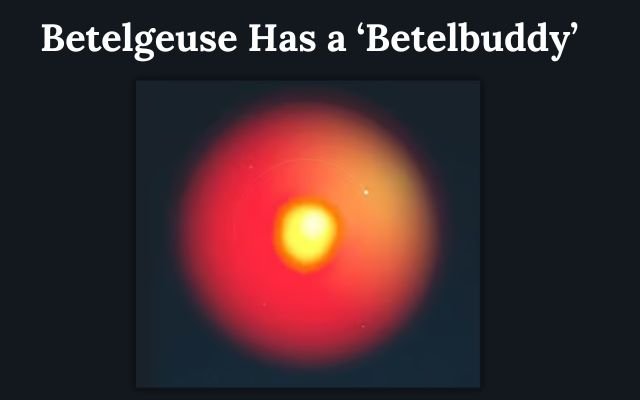Betelgeuse Has a ‘Betelbuddy’: New Findings on the Bright Star’s Companion
Discover new findings about Betelgeuse's companion star, affectionately called "Betelbuddy," and what it means for this bright star.

Orion constellation’s Betelgeuse is a bright star that has been growing brighter and dimmer over time. Some speculated that it would soon burst into a supernova, a massive explosion that occurs when a star reaches the end of its life.
Recent research however, offers alternative reason for these changes in brightness. Scientists claim that Betelgeuse has companion star. As Betelgeuse moves through space, its partner star pushes away dust that would block its brightness. This is reason betelgeuse becomes darker & brighter.
Therefore, rather than being ready to explode Betelgeuse is most likely just interacting with its partner star. This revelation has improved our knowledge of how stars collaborate in universe!
Betelgeuse, one of the night sky’s brightest stars has been exhibiting odd behavior for a while. Many people thought it was about to explode as a supernova because of its sporadic brightening and dimming. However, recent studies suggest a different explanation. It is unlikely that Betelgeuse is nearing the end of its life, but rather that its varying brightness is due to a hidden companion star.
Astrophysicist Jared Goldberg is calling this companion star, formal name Alpha Ori B, the “Betelbuddy”. The Betelbuddy pushes away dust that obstructs some of Betelgeuse’s light as it circles the star like a snowplow. Betelgeuse seems brighter when the dust clears, then the star appears dimmer once more when the dust returns. The pulsing effect of light that scientists have been detecting is produced by this process.
Goldberg and his colleagues have used simulations to study this idea, and their research will soon be published in The Astrophysical Journal. According to Goldberg, they explored many possible reasons for why Betelgeuse’s light changes the way it does. After ruling out every other possibility, they concluded that the most likely cause is the presence of this companion star.
Goldberg worked on this study with Meridith Joyce from the University of Wyoming and László Molnár from the Konkoly Observatory in Hungary. Together, their discoveries help us understand Betelgeuse’s behavior and suggest that a dramatic explosion is not as likely as previously believed! Rather, Betelgeuse is engaging in an intriguing stellar collaboration with its buddy.
Betelbuddy
Betelgeuse is a huge red giant star, about 100,000 times brighter than our sun and 400 million times larger in volume. It is nearing the end of its life, and when it does, we will be able to see the explosion during the day for weeks since it will be so bright. Astronomers have been attempting to determine when this explosion, known as a supernova, would occur.
As a “variable star,” betelgeuse’s brightness fluctuates over time, resembling a heartbeat. Betelgeuse really has two “heartbeats.” One evolves over around six years, while the other over a little over a year. Understanding these pulses, according to scientists, may provide hints about the star’s impending explosion.
One of these pulses is caused by the star itself, called its “fundamental mode.” If the shorter pulse is Betelgeuse’s fundamental mode, then the longer one is caused by something outside the star. Many researchers think this longer pulse is due to a companion star, or “Betelbuddy,” that orbits Betelgeuse and clears away dust that blocks the star’s light. This dust movement makes Betelgeuse look like it’s getting brighter and dimmer.
Scientists aren’t entirely sure what causes these long cycles of brightening and dimming. One theory is that the companion star moves through the dust that Betelgeuse produces and throws off, which changes how much of Betelgeuse’s light we can see from Earth.
Researchers looked at other possible explanations, like activity inside the star or changes in its magnetic field, but none of those made sense. After combining data from observing Betelgeuse and using computer models to simulate the star’s behavior, they concluded that the Betelbuddy is the most likely reason for the long secondary period.
Jared Goldberg, one of the researchers, said, “Nothing else made sense. If there’s no Betelbuddy, then something really strange is happening that we can’t explain with the current knowledge of physics.”
The team hasn’t figured out exactly what the Betelbuddy is yet. They think it could be a star up to twice the size of the sun. Meridith Joyce, another scientist on the team, suggested it could even be a neutron star, which is the remains of a star that already went supernova. However, if that were true, we’d expect to see X-rays, and they haven’t found any so far.
While they’re still not sure about the exact nature of Betelgeuse’s companion, this research gives us a fascinating look at what might be happening around one of the brightest and most interesting stars in the night sky.
A Fresh Look at Betelgeuse (Old Star)
The research team plans to take the next step by trying to capture images of Betelgeuse’s companion star, the “Betelbuddy,” using telescopes. There’s a possible chance to see it around December 6.
“We need to confirm that the Betelbuddy exists because our findings are based on indirect evidence, not direct observation,” says László Molnár, one of the researchers. They are now preparing proposals for these telescope observations.
The cooperation of scientists with various skills enabled this investigation. Meridith Joyce specializes in star modeling, Jared Goldberg analyzes and simulations big stars, and Molnár is an expert in space-based observations and data interpretation. It would not have been able to make this discovery without their combined efforts. Joyce gives special recognition to the Flatiron Center for Computational Astrophysics for fostering atmosphere that promotes this kind of inclusive collaboration.
The team is excited about discovering new details about Betelgeuse, a star that has been studied for a long time. Molnár adds, “Betelgeuse has been the subject of countless studies for decades, yet there’s still more to learn. In this case, we might have found a sunlike star hiding in plain sight, behind the intense glow of a red supergiant. That’s what excites me the most.”
- The Science Behind Sleep: Why You Need It
- 7 Common Myths About Black Holes Debunked
- 11 Valuable Facts About Venus
Overview of the Flatiron Institute
Flatiron Institute is part of the Simons Foundation. Its goal is to improve scientific research using computers for tasks like data analysis and modeling. The Center for Computational Astrophysics at the institute creates tools that help scientists study large sets of astronomical data and understand complicated physical processes in space.



